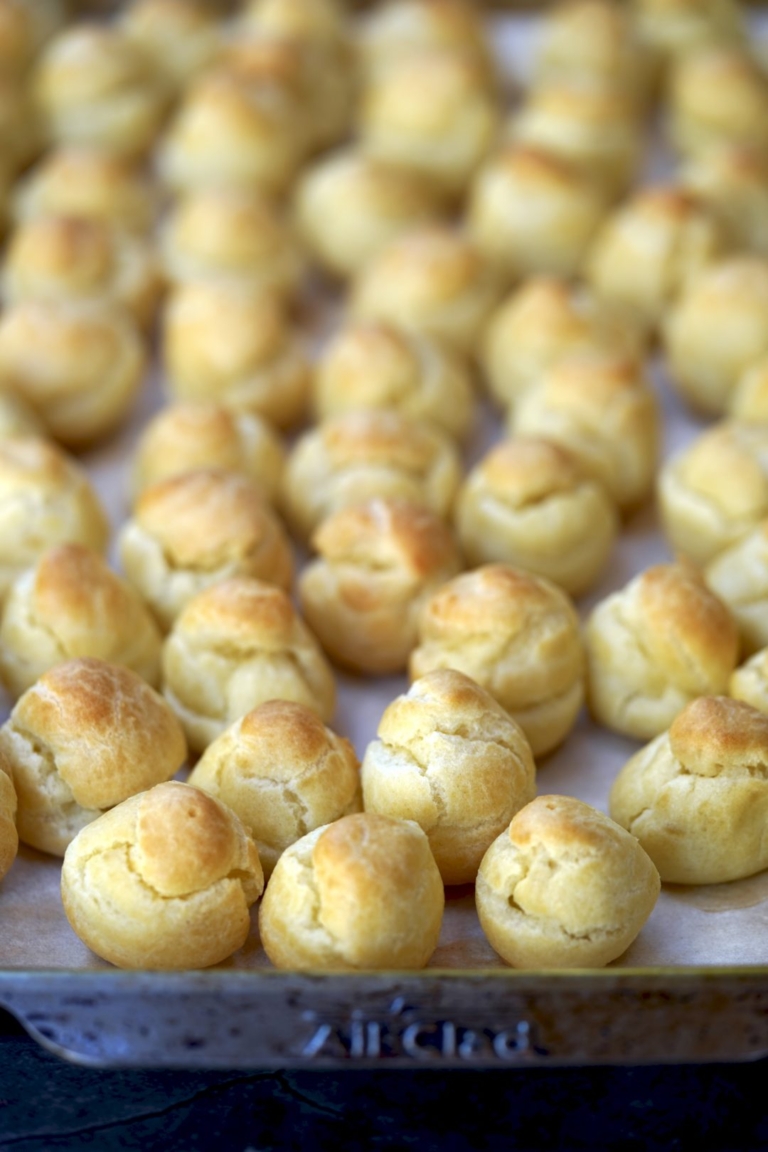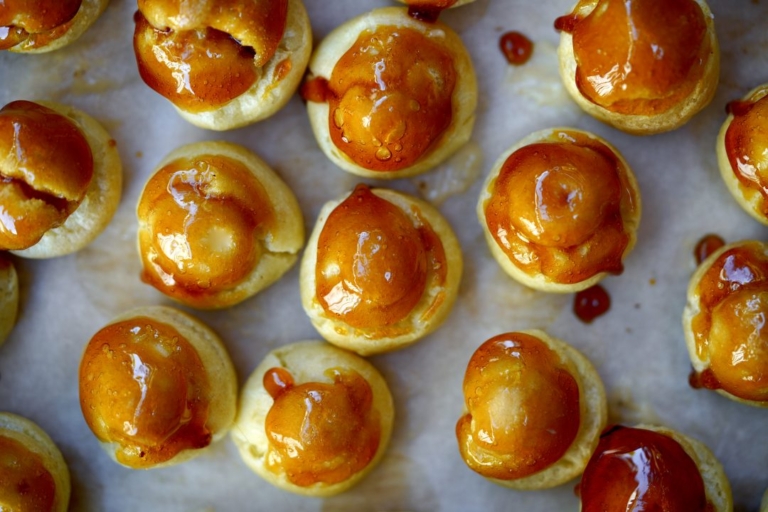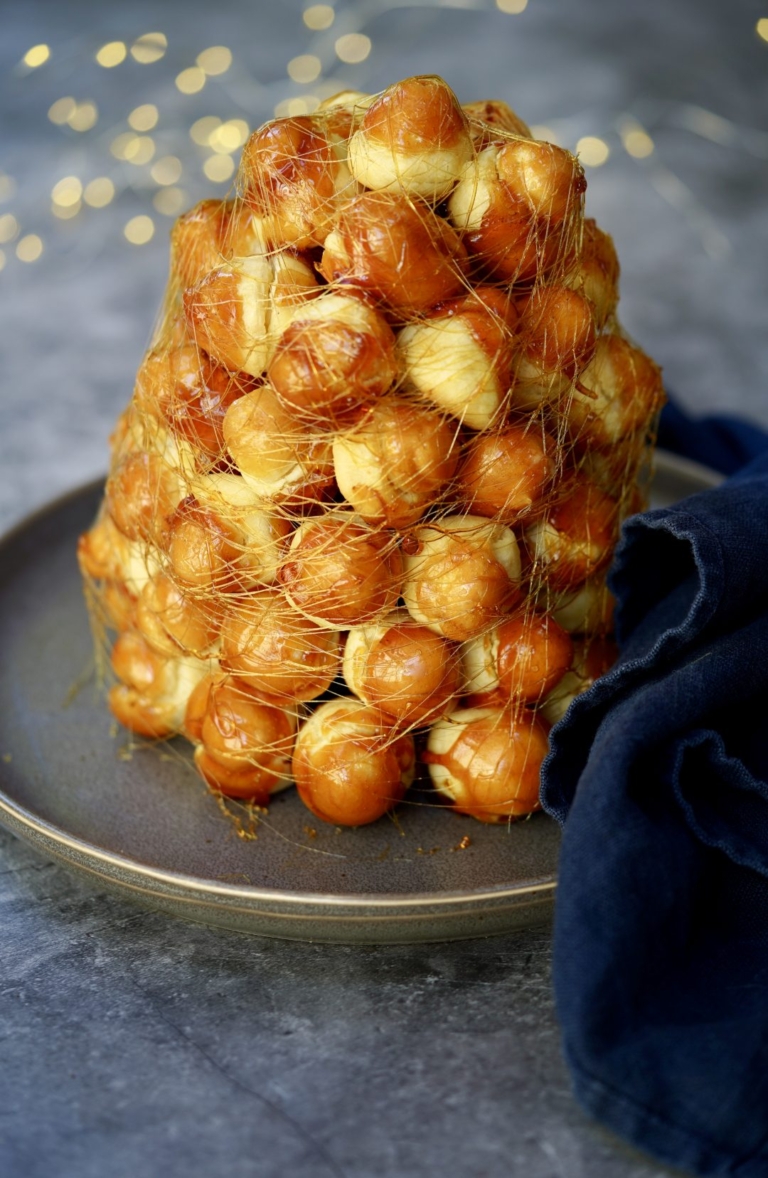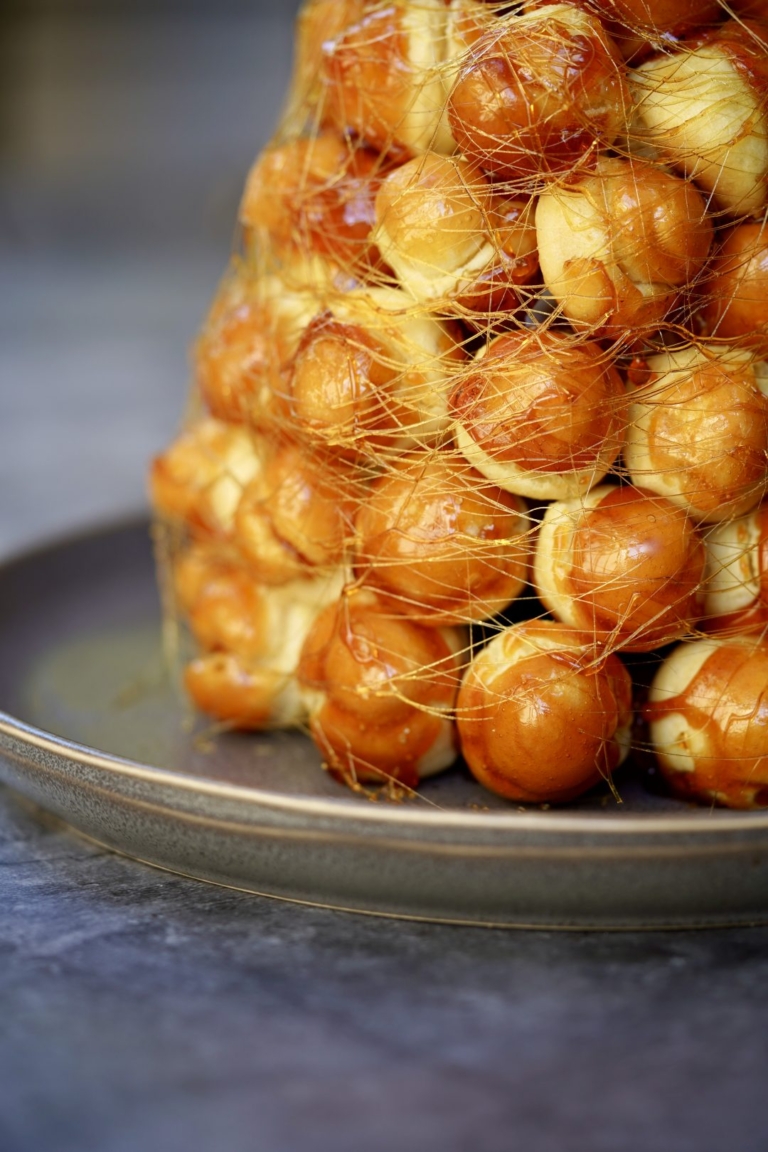Croquembouche
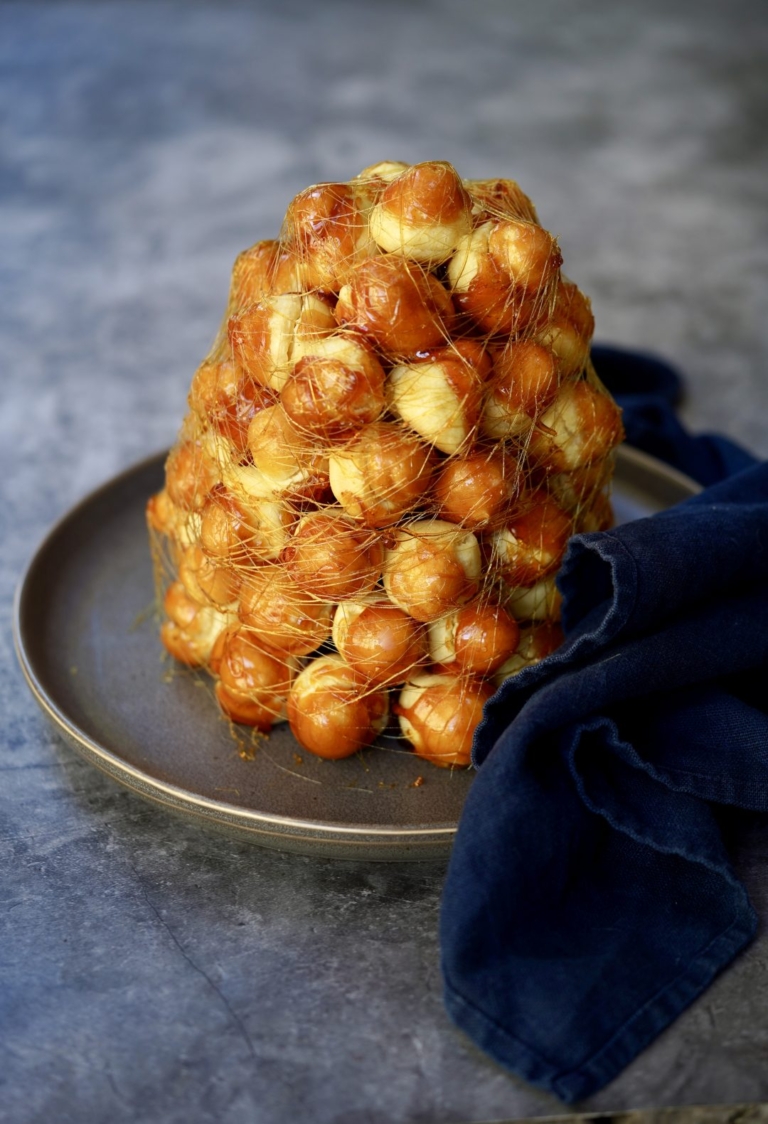
This is what happens when your kids watch Gordon Ramsay’s MasterChef Jr, and this is why I love cooking shows. Never in a million years would have I thought to make this recipe with my kids (ages 7 and 9 at the time), yet I did. The results were surprisingly decent. Croquembouche pronounced “croque-en-bouche”, is a beautiful French dessert consisting of choux pastry balls, filled with rich pastry cream, pilled into a towering cone, and bound with spun sugar. In France and Italy, a croquembouche is commonly seen at special life events such as weddings, baptisms, and first communions.
Croquembouche can be traced back as far as 1806 where it’s referenced in Alexandre Viardi’s culinary encyclopedia, Le’ Cuisine Imperial, and refined in early texts as an elaborate dish served between courses during large banquets. If you have ever seen one in person, they are truly stunning works of art, that are often elaborately decorated with sugared almonds, chocolate, and even edible flowers.
Growing up, I distinctly remember a little bakery on Bleecker Street in New York City, near where I lived, which showcased their towering croquembouche creations during the holidays. I was intrigued, even as a young child, and amazed by their beauty and size. One year my mom got me a croquembouche instead of a traditional birthday cake, it did not disappoint.
A few years ago, the television show MasterChef Jr. featured a mini croquembouche challenge, and my kids were hooked. How could these young kids possibly complete this task, they wondered? But they did, and very well I may add. My seven-year-old quickly questioned if I was “capable of making such a dessert“, and if so, could we? As a parent, I felt compelled to show him my “capabilities“. So, much to even my surprise, I agreed to this ask to attempt making croquembouche with them one weekend. Despite cooking with my kids all their lives, this was a large endeavor, huge really, but it was not impossible.
The three recipes that are needed to make a proper croquembouche, pate a choux, pastry cream, and caramel, are all ones you learn in culinary school. On their own, they are somewhat simple, but the assembly of a croquembouche was another story entirely. This was a great culinary cooking challenge, it took hours, too many to remember, the kitchen was a complete disaster and I may have raised my voice more than a few times, but we did it!
The boys were so impressed by the result, that our beautiful, slightly lopsided, croquembouche was featured at dinner that night as our starting course. I will never forget the joy and sense of accomplishment on their faces as they devoured our tower (or a good portion of it) with great joy and satisfaction. Thankfully, for me, I have a wonderful husband who cleaned up the kitchen.
I recently decided to make another croquembouche, this time without my boys’ help, and this is the one you see here. A croquembouche, with or without the elaborate spun sugar, is a labor intensive endeavor, but if like me, you’re back in COVID lockdown, it fills time. This French classic makes a great celebration dessert, so if you happen to be looking for a show stopper at your Christmas or New Years meal this year, look no further.
Croquembouche
Ingredients:
For the Pate a Choux:
- 8 tablespoons unsalted butter, cut into pieces
- 1 cup water
- Pinch of salt
- 1 1/4 cup all-purpose flour
- 4 large eggs
For the Pastry Cream:
- 2 cups whole milk
- 1/2 cup sugar
- 1/4 cup cornstarch
- 5 egg yolks
- 1 teaspoon vanilla extract
- 1/2 vanilla bean, split lengthwise and seeds scrapped
- 4 tablespoons unsalted butter
For the Caramel:
- 2 1/2 cups sugar
- 1/2 cup water
- 2 tablespoons light corn syrup
Directions:
- For the Pate a Choux: Preheat the oven to 425 degrees F. Line 2 baking sheets with parchment paper and set aside.
- Place the butter, water and salt in a medium saucepan over medium-high heat and bring to a boil.
- When the butter has melted, reduce the heat to medium. Add the flour all at once and cook, beating continuously with a wooden spoon until the mixture pulls away from the sides of the pan and begins to form a ball, about 30 seconds. Transfer the mixture to a medium size mixing bowl and let cool for 2-3 minutes. When the mixture has cooled slightly, add the eggs, 1 at a time, beating well to incorporate.
- Transfer the warm mixture to a pastry bag with a metal tip and pipe about 18 mounds or so about the size of a quarter, 1 inch apart. Note: you can trace circles on the back of the parchment paper for extra accuracy in sizing.
- Bake the choux until puffed and golden, about 20-25 minutes. They should sound hallow when you tap on them. Remove from the oven. Using a tooth pick, prick each profiterole once on top to let the steam out. Return to the oven and cook an additional 3-4 minutes. Cool completely.
- For the Pastry Cream: In a medium saucepan, bring the milk and vanilla bean to a simmer over medium heat till sugar dissolves and mixture begins to simmer.
- In the meantime, using a medium size mixing bowl, whisk the egg yolks and sugar until pale and light, about 3 minutes. Add the cornstarch and whisk well to incorporate. In a slow, steady stream begin to add the hot milk mixture to the eggs while whisking constantly.
- Strain the mixture back into the saucepan you were using. Discard the vanilla bean. Place the saucepan over medium heat and cook, whisking constantly, until the mixture is thick, do not allow to boil. You will know the mixture is done when it is thick enough to hold whisk marks.
- Strain the custard through a fine-mesh sieve into a medium size mixing bowl. Cover with plastic wrap, pressing directly onto the surface of the cream to prevent a skim from forming. Chill pastry cream until sol, about 2 hours.
- For the Caramel: Fill a large bowl with ice water and set aside.
- In a medium saucepan bring sugar, water and corn syrup to a boil over medium-high heat stirring to dissolve the sugar. Boil the mixture, using a damp pasty brush to brush down the sides of the pan, swirl occasionally (do not stir) until the caramel begins to turn a light amber color.
- Remove from the heat and place the saucepan in the ice water bath to stop the cooking process and firm the caramel slightly. Note: if the caramel is too thin, it will be too runny.
Note on Assembly
To assemble the croquembouche, first get everything neatly organized, you will need all the help you can get. Before you make the caramel, fill the pastry choux. Fit a pastry bad with a small star tip. Transfer some of the chilled pasty cream into the bag. Working one choux at a time, gently pipe some pastry cream in to fill, be careful not to overfill or they will split apart. Place the filled choux back on the sheet tray. The pastry will begin to get soggy as soon as they are filled, so wait until just before serving to fill. Once all the choux has been filled, set aside and make the caramel.
Croquembouche Assembly
Carefully, working one at a time, dip the top third of the filled choux into the warm caramel and place caramel side up on a large round serving platter. You want just enough caramel to allow you to glue the pastries together. If the caramel become too hard while doing this, reheat over a medium low flame to loosen. Try to use 10 of the largest choux pastrias to make the bottom layer.
Next, set out 9 choux pastries to make your second layer (you may not need all of them). Dip in the caramel as you did with the bottom layer, placing then caramel side down and trying your best to secure the choux in the spaces between the bottom choux (this will make the croquembouche more sturdy).
Continue to build your croquembouche, making slightly smaller circles for each layer reheating the caramel as needed. Complete the tower with one choux on top. Feel free to make a small one if desired, you will have extra choux, but remember this is an ambitious dessert, it is completely fine to start small and make it larger a second time if you enjoy.
Spun Sugar Decoration
Once the croquembouche is assembled, let the caramel in pan cool until it begins to form a thread when you lift it from the pot with a fork. The cooler the caramel gets, the faster it will begin to harden literally in the air, so you need to work quickly. Dip your fork in the caramel and quickly circle over and around the croquembouche, letting the caramel fall where it may. The puffs will become encased by the threads of caramel. This is what makes the pastry so stunning to look at. Let the caramel harden slightly before serving and congratulate yourself for a huge endeavor!

